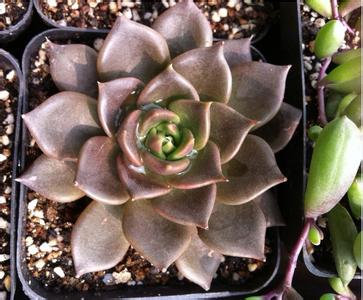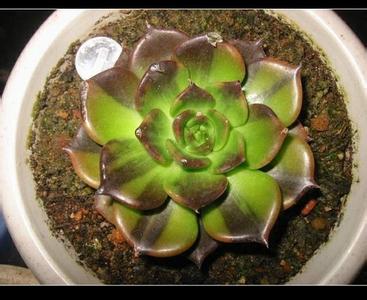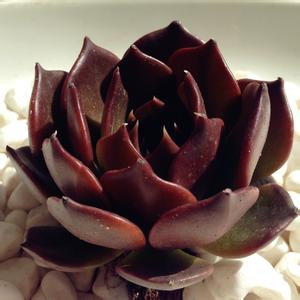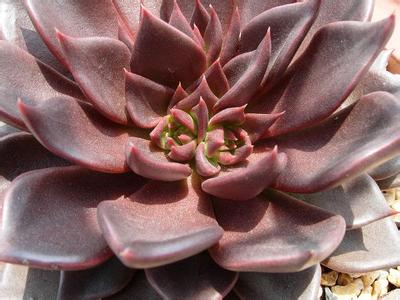The breeding method of the Black Prince
The Black Prince, what a beautiful name, many people will think of the Black Prince in the game World of Warcraft, but here I would like to introduce a perennial succulent herb of the genus Euphorbiaceae. Next from this article to introduce to you how to raise the succulent black prince? The breeding method of the succulent Black Prince.

The breeding method of the Black Prince
Black Master and Black Prince are both cultivated varieties, their habits are basically similar, both like warm, dry and sunny environment, drought-resistant, not cold-resistant, slightly resistant to semi-shade.
The plant has a short dormant period at high temperature in summer, when the plant growth is slow or completely stagnant, can be maintained in a well-ventilated place to avoid long-term rain, and slightly shaded, controlled watering, and do not apply fertilizer.
Spring, autumn and early summer are the main growing periods of the plant, which should be given sufficient sunlight. Although it can grow in the semi-shade, it will become dark green near the growing point, and the dark purple of the leaves in other parts will also become light brown, affecting ornamental.
In addition, excessive nitrogen fertilizer in the soil and overgrowth of plants will also cause this phenomenon.
Therefore, usually make the pot soil a little drier, let the plant grow a little slower but will get a better effect.

In winter, if the lowest temperature is not less than 10 ℃, it can be watered normally to make the plant continue to grow, but there is no need to apply fertilizer; if it can not maintain such a high temperature, control watering, make the plant dormant, can also withstand the low temperature of 3-5 ℃.
When the basin is changed every 1-2 years, the basin soil is required to be fertile and has good drainage. 2 parts of coarse sand or vermiculite, 1 part of rotten leaf soil and 1 part of garden soil are often used after mixing. If an appropriate amount of plant ash or bone powder is added as base fertilizer, the effect is better.
The Black Prince is strong, and the management can be a little more extensive. Attention should be paid to watering during the summer dormancy period, so as not to cause rotting roots due to excessive wetness of the soil. In winter, due to less light, the leaves will turn green, especially the newly grown leaves, which are more obvious, but do not need to take care of it. After the arrival of spring, with the increase of light, it will gradually become black and purple.

Planting and maintenance of the Black Prince
The plant has a short dormancy period at high temperature in summer, when the plant growth is slow or completely stagnant, and the Black Prince has strong habits. Although there is a short dormancy period in summer, it is not difficult to save water by shading and ventilation.
Spring, autumn and early summer are the prosperous periods for the growth of the Black Prince, which should be given sufficient sunshine and liquid fertilizer can be applied. Although the Black Prince can grow in the semi-shade, it will turn dark green near the growing point, and the dark purple of other parts of the leaves will also become light brown or even green, affecting the ornamental. In addition, excessive nitrogen fertilizer in the soil and overgrowth of plants will also cause this phenomenon. Therefore, usually make the pot soil a little drier, let the plant grow a little slower and get a better effect. However, if the potted soil is too dry, it is easy to cause the old leaves of the Black Prince to wither.
In winter, if the lowest temperature is not less than 10 ℃, it can be watered normally to make the plant continue to grow, but there is no need to apply fertilizer; if it can not maintain such a high temperature, control watering, make the plant dormant, can also withstand the low temperature of 3-5 ℃. In winter, due to less light, the leaves will turn green, especially the new leaves, more obvious, but do not care about it, and so on after the arrival of spring, with the increase of light will gradually become black and purple.
When the basin is changed every 1-2 years, the basin soil is required to be fertile and has good drainage. 2 parts of coarse sand or vermiculite, 1 part of rotten leaf soil and 1 part of garden soil are often mixed and used. If an appropriate amount of plant ash or bone powder is added as base fertilizer, the effect is better.

The mode of reproduction of the Black Prince
The reproduction of the Black Prince can be carried out by breaking mature and complete leaves during the growth period, hang them for 1 or 2 days before insertion, tilt slightly or lay them flat on vermiculite or sandy soil, maintain a little moisture, and soon take root at the base, and grow new buds, often burst many new buds, quite amazing, and so the new buds grow a little larger, and then planted into new plants; you can also use young plants sprouting next to the old plants of the Black Prince, which are also easy to survive.
Matters needing attention in breeding the Black Prince:
The Black Prince is strong, and the management can be a little more extensive. Attention should be paid to watering during the summer dormancy period, so as not to cause rotting roots due to excessive wetness of the soil. In winter, due to less light, the leaves will turn green, especially the newly grown leaves, which are more obvious, but do not need to take care of it. After the arrival of spring, with the increase of light, it will gradually become black and purple.

A brief introduction to the succulent Black Prince:
The Black Prince is a perennial succulent herb of the genus Euphorbiaceae, with short stems and fleshy leaves arranged in a standard rosette. When growing vigorously, the leaf disc can reach 500px in diameter, and the leaves are spoon-shaped, slightly thick, apical, black-purple, Cymes, and florets red or purplish red. The Black Prince's perfect rosette leaf plate and special leaf color make it highly ornamental, very eye-catching, and easy to cultivate and breed, so it is a good product for family potted plants.
The growth habits of the Black Prince
Black Prince is a cultivated variety, like warm, dry and sunny environment, drought-resistant, not cold-resistant, slightly resistant to semi-shade.
How to raise the succulent Black Prince:
The Black Prince has a strong habit. Although there is a short dormant period in summer, it is not difficult to save water with a little shade and ventilation. Early spring and autumn are prosperous periods of growth, and liquid fertilizer can be applied. The potted soil should not be too dry, or the old leaves will wither. General garden soil can be used for planting. Like warm, dry and sunny environment, drought-resistant, not cold-resistant, slightly resistant to semi-shade.

Conclusion: the above is the introduction of the breeding technology of the Black Prince. The Black Prince is a succulent plant, similar to a black lotus flower, with unique shape, beautiful leaves and bright flowers, so it is very popular with people. I hope the content above will explain to you.
Leaves will turn green, especially the new leaves, more obvious, but do not care about it, and so on after the arrival of spring, with the increase of light will gradually become dark purple.

A brief introduction to the succulent Black Prince:
The Black Prince is a perennial succulent herb of the genus Euphorbiaceae. The plant has short stems and fleshy leaves are arranged in a standard rosette. When growing vigorously, its leaf disc diameter can reach 500px, leaf spoon-shaped, slightly thick, tip, black-purple leaves, Cymes, florets red or purplish red. The Black Prince's perfect rosette leaf plate and special leaf color make it highly ornamental, very eye-catching, and easy to cultivate and breed, so it is a good product for family potted plants.
The growth habits of the Black Prince
Black Prince is a cultivated variety, like warm, dry and sunny environment, drought-resistant, not cold-resistant, slightly resistant to semi-shade.
How to raise the succulent Black Prince:
The Black Prince has a strong habit. Although there is a short dormant period in summer, it is not difficult to save water with a little shade and ventilation. Early spring and autumn are prosperous periods of growth, and liquid fertilizer can be applied. The potted soil should not be too dry, or the old leaves will wither. General garden soil can be used for planting. Like warm, dry and sunny environment, drought-resistant, not cold-resistant, slightly resistant to semi-shade.

Conclusion: the above is the introduction of the breeding technology of the Black Prince. The Black Prince is a succulent plant, similar to a black lotus flower, with unique shape, beautiful leaves and bright flowers, so it is very popular with people. I hope the content above will explain to you.
Related
- Wuhan Hospital Iron Tree Blooming Result Was Instantly Frightened by the Gardener Master
- Which variety of camellia is the most fragrant and best? Which one do you like best?
- What is the small blue coat, the breeding methods and matters needing attention of the succulent plant
- Dormancy time and maintenance management of succulent plants during dormancy
- Minas succulent how to raise, Minas succulent plant pictures
- What are the varieties of winter succulent plants
- How to raise succulent plants in twelve rolls? let's take a look at some experience of breeding twelve rolls.
- Attention should be paid to water control for succulent plants during dormant period (winter and summer)
- Watering experience of twelve rolls of succulent plants
- Techniques for fertilizing succulent plants. An article will let you know how to fertilize succulent plants.



